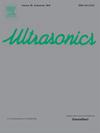Renal denervation guided and ablated by noninvasive ultrasound in canines
IF 3.8
2区 物理与天体物理
Q1 ACOUSTICS
引用次数: 0
Abstract
This study aimed to explore the application and efficacy of a novel stimulation-guided, targeting ablation, and efficacy verification technique based on dual-frequency extracorporeal focused ultrasound interference for renal denervation (RDN) in treating resistant hypertension. Existing RDN techniques are often invasive or lack clear intervention targets and efficacy endpoints, limiting their effectiveness and safety. To address these limitations, we developed a technique using dual-frequency extracorporeal focused ultrasound interference, which modulates acoustic radiation force to stimulate renal nerves for targeted RDN. Initial validation in C57 mice sciatic nerves demonstrated that differential-frequency stimulation (Δf = 40 kHz) achieved effective neuromuscular activation (leg twitching with recorded action potentials) at 0.25 W acoustic power, whereas same-frequency stimulation required significantly higher power (1.25 W) to elicit responses (P < 0.001 for action potential amplitude comparison).In old beagles, acoustic stimulation (with stimulation parameters set at 50 W acoustic power and a Δf = 10 kHz,) was applied across multiple cross-sectional quadrants of the main renal artery to identify and selectively ablate significant blood pressure response sites (≥5 mmHg). Further RDN was achieved through re-stimulation verification and supplementary ablation. Our findings reveal a predominant distribution of positive reaction sites in the proximal segment of the renal artery and that nearly one-third of the response sites still reacted to stimulation after ablation, necessitating additional ablation. When compared to anatomic landmark RDN method, the stimulate-guided RDN demonstrated notably superior reductions in systolic BP (14.4 ± 3.1 vs 9.6 ± 4.4 mmHg, P = 0.026) on day 28. Notably, the implementation of this method did not result in any serious complications. Our study suggests that nerve acoustic stimulation guidance has the potential to be further explored as a non-invasive RDN strategy for targeted ablation and efficacy validation in clinical settings.
无创超声引导和消融犬肾去神经
本研究旨在探讨一种基于双频体外聚焦超声干扰肾去神经(RDN)治疗顽固性高血压的新型刺激引导、靶向消融及疗效验证技术的应用和疗效。现有RDN技术往往具有侵入性或缺乏明确的干预靶点和疗效终点,限制了其有效性和安全性。为了解决这些限制,我们开发了一种使用双频体外聚焦超声干扰的技术,该技术可以调节声辐射力来刺激靶向RDN的肾神经。对C57小鼠坐骨神经的初步验证表明,差频刺激(Δf = 40 kHz)在0.25 W的声功率下可实现有效的神经肌肉激活(记录动作电位的腿抽搐),而同频刺激需要明显更高的功率(1.25 W)才能引起反应(P和lt;0.001为动作电位振幅比较)。在老比格犬中,声学刺激(刺激参数设置为50 W声功率和Δf = 10 kHz)在肾主动脉的多个横截面象限上施加,以识别并选择性地消融显著的血压反应部位(≥5 mmHg)。通过再刺激验证和补充消融进一步实现RDN。我们的研究结果显示,阳性反应部位主要分布在肾动脉近段,近三分之一的反应部位在消融后仍对刺激有反应,需要进一步消融。与解剖地标性RDN方法相比,刺激引导的RDN方法在第28天的收缩压降低明显优于解剖地标性RDN方法(14.4±3.1 vs 9.6±4.4 mmHg, P = 0.026)。值得注意的是,这种方法的实施没有导致任何严重的并发症。我们的研究表明,神经声刺激指导作为一种非侵入性RDN策略在靶向消融和临床疗效验证方面具有进一步探索的潜力。
本文章由计算机程序翻译,如有差异,请以英文原文为准。
求助全文
约1分钟内获得全文
求助全文
来源期刊

Ultrasonics
医学-核医学
CiteScore
7.60
自引率
19.00%
发文量
186
审稿时长
3.9 months
期刊介绍:
Ultrasonics is the only internationally established journal which covers the entire field of ultrasound research and technology and all its many applications. Ultrasonics contains a variety of sections to keep readers fully informed and up-to-date on the whole spectrum of research and development throughout the world. Ultrasonics publishes papers of exceptional quality and of relevance to both academia and industry. Manuscripts in which ultrasonics is a central issue and not simply an incidental tool or minor issue, are welcomed.
As well as top quality original research papers and review articles by world renowned experts, Ultrasonics also regularly features short communications, a calendar of forthcoming events and special issues dedicated to topical subjects.
 求助内容:
求助内容: 应助结果提醒方式:
应助结果提醒方式:


